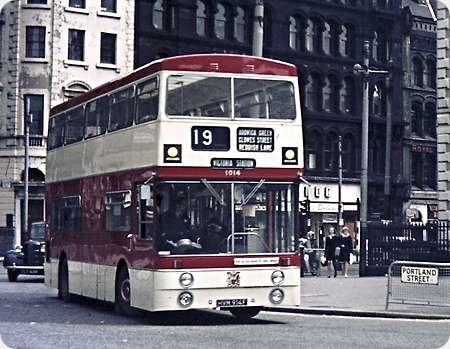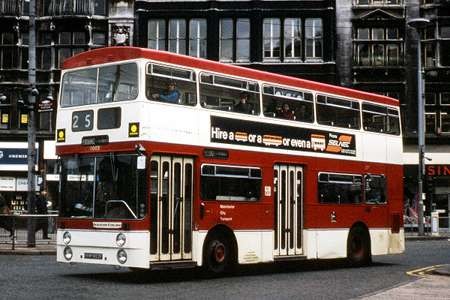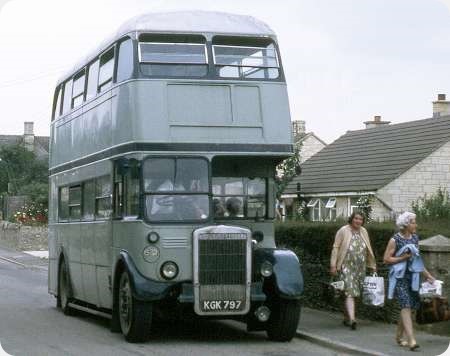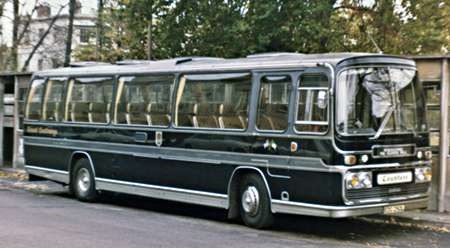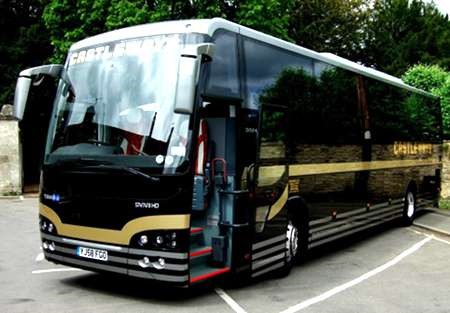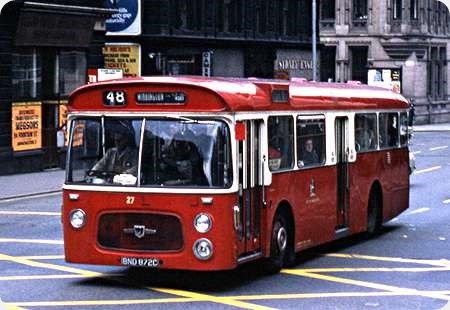Manchester Corporation – Leyland PDR1/1 – HVM 914F – 1014
Manchester Corporation
1968
Leyland Atlantean PDR1/1
Park Royal H45/28D
One of the famous Mancunians which revolutionised the double deck bus in the late 60s is seen turning into Portland Street in May 1968 when just a couple of months old. The stunning livery brightened up Manchester – sad that they soon succumbed to SELNEC orange and white.
Photograph and Copy contributed by Ian Wild
25/05/20 – 07:24
1014 was one of the vehicles delivered in the cream and red livery based on the scheme previously used on the Panther single deckers. It was displayed in Piccadilly along with 1001 which was in the white version of the livery and the public were asked to comment. The result was a majority in favour of white so 1014 and, I think, 1017 went back to the spray booth.
Phil Blinkhorn
26/05/20 – 06:54
Phil, you are too modest. Part Four of your expansive article, Manchester Buses – A Retrospective, gives the comprehensive story behind the Mancunian double deck design:- Manchester Buses a Retrospective – Article
Here is another picture, showing the nearside, of one of the early Atlanteans, No. 1003 HVM 903F, taken in June 1970. In 1968 Ralph Bennet moved on to London Transport, later becoming first Deputy and then Chairman. There he came up against the exhibitionist and rabid Thatcherite leader of the GLC, Horace Cutler, who engineered his early removal from office in 1980 on the politically motivated, utterly preposterous grounds that he lacked the necessary managerial expertise. Cutler’s transport legacy of cost cutting, asset stripping and under investment is still felt in London to this day.
Roger Cox
26/05/20 – 06:55
I have a soft spot for these first Atlantean Mancunians. I travelled the 19 route regularly on my journeys from Work, when I was in digs at Debdale Park while working in Denton. Hyde Road also used these on the 169/170 services, to which there is a clue in the destination number box. The 1 has been left, the 6 or 7 wound to 9 and the last last digit the 9 or 0 wound off. Keen drivers would correctly have just used the second and third tracks only, far neater in my opinion. If I could not sit at the front upstairs my second choice was the rear offside seat over the engine to listen to it. The 19 was very convenient for me as the short walk from Victoria Station to Greengate would get me on a 12/31/38 to visit my parents at Little Hulton. To add to Phil’s comments about the colours, perhaps we can add that it was 1044 that later on, suffered a most catastrophic fire. Question to Phil, there was also the first demonstration of a Mancunian in Piccadilly, but that was to demonstrate it against two other operators new buses, neither came near to it.
Mike Norrios
26/05/20 – 06:55
Since my previous comment, I’ve found the record of the deliveries and repaints. There were 7 deliveries for entry into service in March 1968. 1001/03/04/05/10/14/24. Of these 1003/04/14 and 1024 were delivered in red and cream, the rest in red and white. On Saturday February 24 and Saturday March 2 two vehicles were displayed and free rides given in Piccadilly bus station. 1001 in white and 1024 in cream took part with 1014 substituting for 1024 the second Saturday. March deliveries for April entry into service included 1002 also in red and cream but as a result of both the public opinion surveys and previous comments about the cream yellowing on the Panthers – shades of problems to come with SELNEC’s sunglow orange – all five red and cream vehicles were resprayed within six weeks.
Phil Blinkhorn
26/05/20 – 10:53
A Sheffielder, I spent my student days in, and around, Manchester from 1971-1976 – and then stayed to work until December 1980. The Sheffield "standard" PRV body on the 163 Atlanteans and subsequent Fleetlines – and the later London Country/NBC version – is a favourite of mine. However, I always preferred the 33ft Mancunian by PRV/MCW/Roe, but I always felt it was better and more balanced in design as a 33footer rather than this original, shorter, version.
David Oldfield
26/05/20 – 10:55
Mike, the demonstration you refer to was after the 1968 Commercial Motor Show on October 26 when the show exhibit Mancunian, Fleetline 2048 which had been held back to be exhibited by Park Royal, was shown on Piccadilly alongside Sheffield Atlantean 293, also straight from the Park Royal stand at the show and Newcastle 601 an Alexander bodied Atlantean whose hitherto advanced styling was totally eclipsed by the other two with the Mancunian going on to be the template for future double deck design.
Roger, it’s interesting how a later London leader of the same political kidney and with no real experience in transport, wasted millions in removing vehicles found quite satisfactory in cities large and small around the globe and replacing them with a vanity project which could not be operated as designed, cooked the passengers in summer and were designed to look from the rear to fulfil all the meanings of "like the back end of a bus".
Phil Blinkhorn
27/05/20 – 07:04
Phil, My thanks to you.
My memory seems to recall the Newcastle one, have a reversed nearside staircase, or what the Sheffield one? There was something very peculiar about it, on one of them.
Mike Norris
27/05/20 – 07:05
Who on earth, and what bus, can Phil possibly be referring to?!
Stephen Ford
28/05/20 – 07:12
I guess that Phil Blinkhorn didn’t actually live along one of the routes that the London Bendys actually ran on. Their obstructive characteristics really became apparent where, as they tended to do far more than regular vehicles, they ended up running in tandem. I believe there was an instruction that they were not to overtake one another.
They also had a higher accident record than normal vehicles. I know it’s sometimes presented as no different, but these vehicles paid an additional rate and were only driven by experienced senior drivers who otherwise had a much lower than average accident rate.
Sir Peter Hendy stated there was no loss on the disposal of them because they were leased, and just handed back at a lease break point.
When it comes to "experience in transport", we can possibly start with a manufacturer who states the first one destroyed by fire was a "unique incident", the second one was a "extraordinary coincidence", and the third one was "er … we’re going to do a modification". I can still see where the classic trees on Park Lane were ruined by the 436 which caught fire there.
Bill
28/05/20 – 07:14
Mike, it was the Newcastle Atlantean that had the near side staircase – a bit of a Newcastle fad at the time.
Phil Blinkhorn
29/05/20 – 06:52
601 was a conversion by Newcastle Corporation of accident damaged 251(KBB 251D). One of the claimed advantages was that the layout gave the driver a better view of the exit door. I believe Newcastle took two batches of Alexander bodied Atlanteans to this layout. Tyneside PTE, and subsequently Tyne and Wear PTE, adopted this speciation. It appeared on Daimler Fleetline chassis, and Willowbrook built some bodies of this layout for the PTE on long Atlantean chassis.
Richard Slater
29/05/20 – 06:53
No Bill, I didn’t live on a bendy bus route but I have driven in cities on five continents where such vehicles operate and they are no more obstructive than any other long vehicle. Their removal was a toxic mixture of the old LT "not invented here" attitude, political reaction to an innovation by an opposing party and flag waving jingoism. Their very expensive replacements are unable to operate either safely or economically as designed. As for fires, 12 of the articulated vehicles were destroyed by fire and fire has also destroyed a number of the new Routemasters – as it has other hybrids and, going back in time, a good number of Atlanteans, Fleetlines, Panthers and other "conventional" buses.
Phil Blinkhorn
01/06/20 – 07:46
We had the very under powered Wright Ftrs in Leeds which were a bit of a disaster to put it mildly York also had some which the council pressurised First into moving to Leeds. York is also home to a number of Mercedes artics on park and ride service which have no problem in the narrow city centre streets.
Chris Hough
09/12/20 – 07:07
In my opinion the Mancunian was the most stylish body/livery combination ever produced on a rear engine double deck chassis. Ignoring the fact that it is not a fully low floor layout, if one of these turned up at anyone’s bus stop today, I doubt if anyone would believe you if you said the design was over 50 years old.
Alan Murray-Rust
11/12/21 – 08:46
Fully agree, Alan.
David P Oldfield
Quick links to the - Comments Page - Contact Page - Home Page
